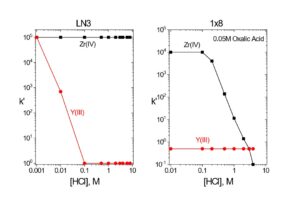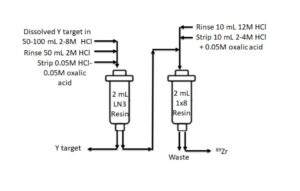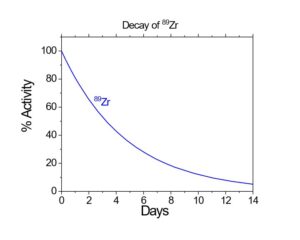Zirconium-89 Separation
89Zr is an emerging PET isotope that is produced from the irradiation of yttrium targets. Following dissolution of the yttrium targets with HCl or HNO3, 89Zr can be selectively extracted using LN3 [1] or ZR Resin[2, 3-5] (Figure 1). Following rinses with 2M HCl to remove Y and other metal ion impurities, the 89Zr can be recovered using dilute oxalic acid or 0.05M HCl-0.05M oxalic acid. From 0.05M HCl-0.05M oxalic acid, the 89Zr may be loaded onto a column of strong base anion exchange resin, allowing additional purification from metal ion impurities and leached extractant. From the anion exchange resin, the 89Zr can be recovered using 2-4 HCl. Addition of dilute oxalic to the 2-4M HCl acid is recommended to prevent losses of Zr due to hydrolysis.
It was further shown [3] that 89Zr may directly be recovered as chloride using TBP Resin. The Y targets were dissolved using concentrated HCl in order to assure an HCl concentration > 9M HCl in the loading solution. Y and trace impurities were removed through rinsing with 9.6M HCl. 89Zr chloride was finally eluted with 0.1M HCl in high purity (mean Zr/Y separation factor of 1.5E5) and high chemical yield (89±3%). However, the authors noted that eluting into dilute HCl will require particular precautions with respect to 89Zr hydrolysis.
References
[1] Eichrom Application Note AN-1622, “Separation of 89Zr from Y Target,” https://www.eichrom.com/wp-content/uploads/2018/02/an-1622_zr-89.pdf
[2] Triskem INFOS, No 15, February 2016. http://www.triskem-international.com/scripts/ files/59d1f4fc31f796.50370140/tki_15_en_web.pdf
[3] S.A. Graves, C. Kutyreff, K. E.Barrett, R.Hernandez, P. A.Ellison, S. Happel, E. Aluicio-Sarduy, T.E.Barnhart, R.J. Nickles, J.W.Engle. Evaluation of a chloride-based 89Zr isolation strategy using a tributyl phosphate (TBP)-functionalized extraction resin. Nuclear Medicine and Biology, 64–65, 2018, 1-7
[4] Gao F et al.: “Two bifunctional desferrioxamine chelators for bioorthogonal labeling of biovectors with zirconium-89.”, Org Biomol Chem, 28, 2018, 5102 – 5106
[5] YuTang, Yingjiang Hua, Weihao Liu, Lin Chen, Yan Zhao, Huan Ma, Jijun Yang, Yuanyou Yang, Jiali Liao, Jiming Cai, Yue Chen, Ning Liu. A radiopharmaceutical [89Zr]Zr-DFO-nimotuzumab for immunoPET with epidermal growth factor receptor expression in vivo. Nuclear Medicine and Biology. 70, 2019, 23-31.



